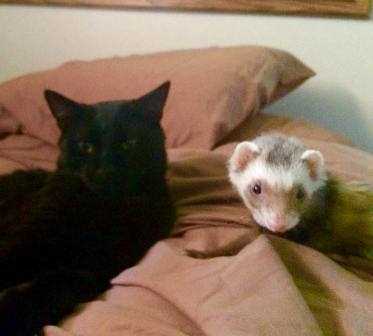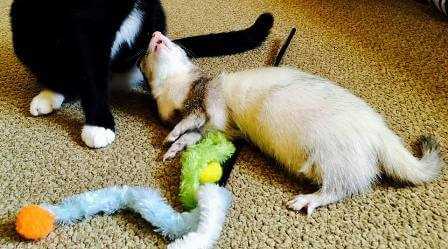

In my experience, the little furry creatures with long bodies and curious minds possess a unique charm that sets them apart from us felines. Unlike my aloof nature, these playful beings thrive on social interaction and display an exuberance that can be quite captivating. If you’re pondering whether to welcome one of these critters into your home, expect a lively companion that craves attention and playtime.
Their energy levels are through the roof, and they’ll keep you on your toes! While I enjoy lounging in sunbeams and observing the world from my cozy perch, my weasel-like companions prefer to explore every nook and cranny. They are natural explorers, often getting into mischief that can leave a trail of chaos in their wake. If you’re looking for a pet that will entertain you with antics, a ferret might be just the ticket.
However, it’s essential to consider the differences in care and lifestyle. Unlike my litter box routine, these little guys require a more specialized diet and a larger space to roam. They thrive in environments where they can explore and engage with various toys and tunnels. Before making a decision, ensure you can provide the necessary environment and care to keep them happy and healthy.
Comparison of My Fellow Companions
My observations show that these small animals possess unique traits that differ significantly from our feline nature. Here’s what I’ve gathered:
Behavioral Differences

- Energy Levels: My friends are often more hyperactive, engaging in playful antics that can last for hours compared to my more relaxed attitude.
- Social Interaction: These creatures tend to be more social and seek companionship, while I enjoy my alone time and occasional snuggles.
- Curiosity: They exhibit boundless curiosity, often exploring every nook and cranny, unlike my preference for observing from a comfy spot.
Dietary Needs
- Protein Requirement: Their diet is higher in protein and fat, which may not align with the more balanced diet I enjoy.
- Specialized Food: They often require specific types of food that cater to their unique digestive systems, different from my usual kibble or wet food.
In conclusion, while we may share some common ground as small mammals, our differences in behavior and dietary needs highlight the unique characteristics of each species. Understanding these distinctions can help potential owners make informed choices about companionship.
Behavioral Similarities Between Weasels and Felines
Having observed the behaviors of my weasel friends, I can confirm that their antics closely mirror some of my own. Both species share a playful nature, often engaging in amusing antics that can entertain for hours. For instance, the way they chase after toys or pounce on unsuspecting objects is quite similar to how I stalk my favorite feathered plaything.
Another interesting trait is their curiosity. Just like I enjoy exploring every nook and cranny of my home, these little creatures are equally inquisitive. They love to investigate new items and spaces, often getting themselves into amusing predicaments.
Social interaction is another commonality. We both thrive on companionship, whether it’s with humans or fellow critters. While I might curl up next to my human for a nap, my weasel pals enjoy snuggling up just as much, showcasing their affectionate side.
In terms of grooming, both species are quite fastidious. I spend considerable time keeping my fur pristine, and I’ve noticed my weasel buddies engage in similar rituals. Their grooming habits reflect a need for cleanliness, which is a trait I truly appreciate.
| Behavior | Weasels | Felines |
|---|---|---|
| Playfulness | Chasing toys | Pouncing on objects |
| Curiosity | Exploring new spaces | Investigating surroundings |
| Social Interaction | Enjoying companionship | Cuddling with humans |
| Grooming Habits | Fastidious cleaning | Preening fur |
For those seeking a way to capture these charming moments, check out the best budget digital camera with flip screen. It’s a great tool to document our playful escapades!
Dietary Needs: Comparing Ferrets and Cats
High-protein diets are critical for both species, but the exact requirements differ. I thrive on a diet rich in animal proteins, typically sourced from chicken or fish. My meals often include dry kibble formulated specifically for felines, providing the necessary nutrients to keep my fur shiny and my energy levels high.
In contrast, the little weasels require a diet composed entirely of meat. They need a higher fat content and specific amino acids like taurine, which is vital for their health. This means their food is usually meat-based, with little to no carbohydrates. Their digestive systems are designed to process protein efficiently, unlike mine, which can handle a small amount of carbs.
Hydration is another crucial factor. I enjoy fresh water daily, but I also indulge in wet food, which helps with hydration. For those furry companions, a steady supply of fresh water is a must, as they often don’t consume enough fluids through their food alone.
Snacks vary too. I might enjoy a few catnip treats or a piece of cooked chicken, while my small counterparts benefit from raw or freeze-dried meat treats. It’s important for them to avoid fruits or vegetables, as their digestive systems cannot process these items well.
When considering feeding options, it’s vital to consult a vet to ensure that the specific dietary needs of either species are met. Balancing proteins, fats, and hydration ensures a long and happy life for both of us.
Social Interaction: How Ferrets and Cats Engage
It’s fascinating to observe the ways we interact with our humans and each other. Both small mammals and my kind share some intriguing social behaviors, but we also have our distinct styles. For instance, I tend to enjoy calm moments with my humans, curling up in their laps and purring softly, while my lively companions prefer to engage in playful antics that involve lots of movement and exploration.
Playful Engagement
When it comes to play, I might prefer a quiet game with a feather toy, while my energetic friends thrive on interactive play that mimics hunting. They love to chase and pounce, often rolling and tumbling around during their escapades. It’s a sight to behold! Understanding this difference helps our humans tailor playtime to suit our individual personalities. They can engage me with slower-paced activities while providing more vigorous fun for my spirited friends.
Communication Styles
Vocalizations are another area where we differ. I often communicate with soft meows and purrs to express contentment or request attention. On the other hand, my lively counterparts can be quite vocal, using a variety of chirps and chattering sounds, especially when they are excited or want to initiate play. Body language also plays a crucial role; while I might flick my tail when annoyed, my energetic pals will often show their excitement by bounding around or darting in circles. Observing these cues can enhance how we interact with our humans and each other.
Understanding these nuances in social engagement can lead to a harmonious household where everyone’s needs are met. Whether it’s a cozy cuddle session or a spirited game of chase, there’s a special bond that forms through these shared experiences.
Space Requirements: Living Conditions for Weasels and Felines
For optimal living conditions, both weasels and felines need adequate space to thrive. A minimum of 24 square feet is recommended for the former, allowing them to explore and engage in their playful antics. The environment should be secure, with plenty of vertical space, such as shelves or cat trees, where they can climb and observe their surroundings.
Felines, on the other hand, can adapt to smaller spaces, but they still require areas to stretch and play. A cozy apartment with a defined territory of around 18 square feet can suffice, provided there are engaging toys and high perches. Each species benefits from designated zones, such as a sleeping area away from the hustle and bustle, which promotes comfort and security.
Environmental Enrichment
Both types of pets thrive in enriched environments. For weasels, tunnels, and hiding spots are essential, as they enjoy exploring and burrowing. Regularly rotating toys keeps their interest piqued. For my feline friends, scratching posts and interactive toys cater to their natural instincts. Window perches also provide entertainment through bird-watching.
Safety and Comfort
Ensuring a safe environment is paramount. Weasels require a secure enclosure to prevent escapes, while felines may need barriers to keep them away from hazards. Temperature control is vital; both species prefer moderate climates. Adequate ventilation and clean bedding contribute to their well-being, as does regular cleaning of their living spaces.
In summary, thoughtful space allocation and environmental enrichment are key to maintaining a happy and healthy home for both weasels and felines.
Training Challenges: Ferrets Versus Cats
Training a small mammal often presents unique obstacles. My experience shows that while I can catch on to commands quickly, my little friends face different hurdles. For instance, they tend to be more easily distracted and may require shorter, more engaging training sessions.
Attention Span

Unlike my focused nature, these critters have a shorter attention span. This means that patience is key. Sessions should be kept under five minutes, allowing plenty of breaks for play and exploration.
Behavioral Incentives
Using treats can be an effective motivator, but the types of rewards differ. I prefer a simple snack, while their diet requires specific protein-rich offerings. Finding the right incentive for them can involve some trial and error. Positive reinforcement works wonders, but the right treat must truly excite them.
Some tricks, like walking on a leash, can be particularly challenging. Their instinct to explore can lead to a chaotic training experience if not managed properly. It’s important to create a safe environment that encourages learning without overwhelming them.
In conclusion, while both of us can learn commands, the approach and techniques needed differ significantly. Understanding these nuances can make training a more enjoyable experience for everyone involved.
Health Considerations: Common Issues in Ferrets and Cats
Regular check-ups are crucial for both species to monitor for specific health issues. For instance, adrenal disease is a common concern in mustelids, leading to hormonal imbalances and various symptoms like fur loss and increased aggression. On the other paw, felines often face conditions like obesity, diabetes, and dental disease, which can be mitigated through proper diet and exercise.
Preventive Care
Vaccinations play a significant role in health management. While many owners are familiar with the necessary shots for cats, ferrets require specific vaccines to protect them from diseases such as distemper and rabies. It’s essential to consult a veterinarian familiar with both kinds of pets to establish a proper vaccination schedule.
Dietary Impact on Health
The nutritional needs differ greatly. High-quality protein is crucial for both, but the dietary composition varies. Felines need a diet rich in animal proteins, while mustelids thrive on higher fat content. This difference can lead to health issues if one is fed the other’s diet. Always consider specialized food formulations for each type to ensure optimal health.
For those with multiple pets, maintaining cleanliness is important. I recommend checking out the best litter for multi cats to help manage their environment effectively and avoid potential health risks associated with poor hygiene.









